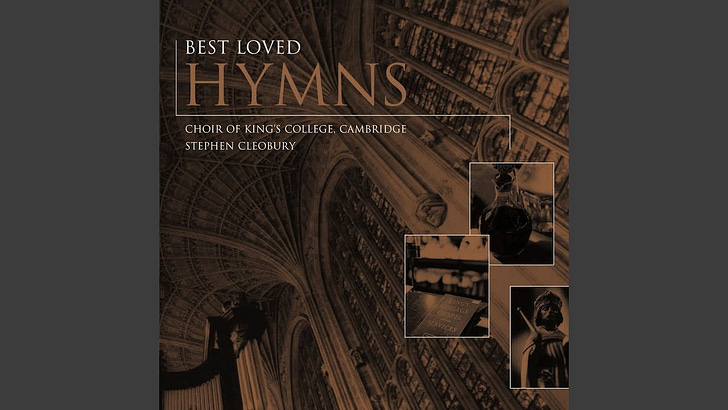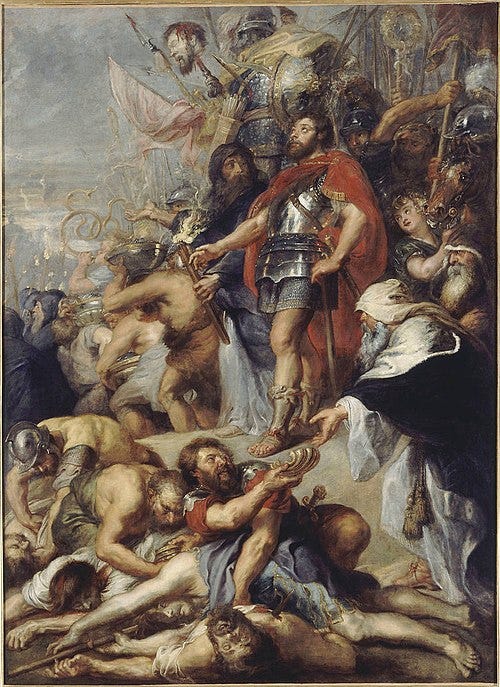Our Hymn of the Week is one of triumph — and is the hymn our son David played on our chapel’s organ for Easter Sunday, for the recessional. Perfect.
Mankind knows about triumph, right? If you ever go to the Roman Forum, look at the Arch of Titus, built to commemorate his destruction of Jerusalem in 70 A.D. It’s appalling to consider that the ramifications of that event are with us still, as you can gather from the sculpture-work on the arch, wherein you may see the Temple raided and the seven-branched candelabrum carried off. A triumph was not the victory itself, by the way, but the triumphal parade. So Titus passed beneath the arch erected for the occasion: he and his army and their long train of captives and plunder.
Alas for the irony of it, the Romans became involved in Palestine in the first place when Judas Maccabeus invited them into an alliance. Judas had driven out the armies of the Greek despot Antiochus IV and rededicated the Temple in 164 B.C., an event the Jews celebrate as Hanukkah. He’d heard about the Romans in those days of the republic, and their senate that consulted always for the common good, and their honesty in keeping their treaties with their allies. Some of that was wishful hoping, no doubt, but the Romans had a better reputation than Antiochus had. There was, at that time, no gouty Roman emperor you were supposed to adore as a god, and no nonsense about worshiping the city of Rome, either. Those Romans wanted to govern; otherwise they let their allies worship as they pleased.
Antiochus, by contrast, had wanted to make the Jews Greek, introducing the gymnasion, for example, for sports and military exercise. That led plenty of Jewish youths to hide the physical sign of their being a people set apart by God. I won’t get into the details. Antiochus set up in the Temple the statue of Zeus, the “abominable idol of desolation.” Don’t we all worship the same God, really? So he might have said, impatient with the Jews. Hanukkah marks a victory against that muddle.
Now come with me to London, 1746. The English armies, after a couple of embarrassing defeats, have routed the mostly Scottish forces of Bonnie Prince Charlie, the Stuart heir to the throne. That was at Culloden; the English general was the young Duke of Cumberland, William Augustus, son of George II. What better way to celebrate than to have the most renowned composer in England, Georg Friedrich Handel, to do it in music, on stage? Handel was German, as was the king; but educated people in those days were not shy of languages. Hence came the English oratorio Judas Maccabeus, as if the Duke of Cumberland had been that brave Jewish war leader fighting against all human and worldly odds, and as if the purity of English worship had been secured against an uneasy alliance of Presbyterian and Catholic Scots who favored Charlie. Judas Maccabeus was a smashing success.
Yet the melody that now goes by that name was not written for that oratorio. Handel composed it five years later for Joshua (1751). People loved it so much, he decided to insert it into the earlier Judas Maccabeus, where it fits quite well, and where it has remained ever since, beginning with the mighty lines, “See, the conquering hero comes: / Sound the trumpets, beat the drums!”
Enjoy this recording by the always excellent King’s College Choir, with a tremendous descant.
Word & Song by Anthony Esolen is a reader-supported online magazine devoted to reclaiming the good, the beautiful, and the true. Join us as subscriber.
Now we go to Switzerland, in 1884. A young Swiss evangelical minister, Edmond Louis Budry, has just lost his beloved wife. Inspired by hope that transcends human sadness, he sets Handel’s triumphant melody to words of his own, about the risen Christ. I’ll give you the first stanza here in Budry’s French. If you know the melody, you’ll see how fine is the fit:
À toi la gloire, O Ressuscité! À toi la victoire pour l’éternité! Brillant de lumière, l’ange est descendu, Il roule la pierre du tombeau vaincu. À toi la gloire, O Ressuscité! À toi la victoire pour l’éternité!
To translate literally: “Thine be the glory, O Risen One, thine the victory for all eternity! The radiant angel has descended; he rolls back the stone of the defeated tomb.” Then the first two lines, serving as the refrain for all three stanzas, are repeated. Magnificent!
How far we are from Culloden, no? “Death is swallowed up in victory,” cries Saint Paul, not just any person’s death, or this or that people’s defeat on the battlefield. Death itself has been vanquished, death “the last enemy,” death our grim master; death has been bound and led captive, and his own carcass gluts the grave. In Budry’s hymn, this conquest is also deeply personal. We can feel what it is to doubt, to waver; Thomas did so, and so did many when Jesus appeared in Galilee, before he began to speak. We need doubt no more. He who comes our way – and Budry will put us in the dramatic position of those who see from a distance, but more and more clearly as the object of our love and praise approaches – is the Lord. “I am not he who condemns,” said the Lord to Francis de Sales. “My name is Jesus.”
The following text is the standard English translation you’ll find in hymnals.
Refrain. Thine be the glory, risen, conquering Son; Endless is the victory Thou o’er death hast won! Angels in bright raiment rolled the stone away; Kept the folded grave-clothes where Thy body lay. Refrain. Lo, Jesus meets us, risen from the tomb; Lovingly He greets us, scatters fear and gloom. Let His church with gladness hymns of triumph sing, For the Lord now liveth; death hath lost its sting. Refrain. No more we doubt Thee, glorious Prince of life! Life is naught without Thee; aid us in our strife; Make us more than conquerors, through Thy deathless love; Bring us safe through Jordan to Thy home above. Refrain.






I want to thank you too for all the works of art (paintings) that you include with the articles.